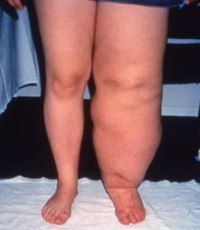Lymphoedema
Introduction

The lymphatic system is a network of fine vessels and nodes throughout the body, it functions to transport tissue fluid (lymph) from the body tissues back to the bloodstream is part of the circulatory system and keeps our body’s fluids in balance whilst also defending against infection. Lymphoedema is a chronic condition that causes swelling in the body tissues. It can develop in any part of the body but is commonly seen in the arms and legs. There are 2 types, namely – Primary and Secondary lymphoedema. Primary lymphoedema is genetically determined and may cause absence (aplasia), increase (hyperplasia) or decrease (hypoplasia) of lymphatic vessels leading to lymph flow imbalance. It may be congenital, develop at the onset of puberty (praecox) or even later in adult life (tarda). Conversly, Secondary lymphoedema develops due to damage to the lymphatic system caused as result of injury, cancer, infection, obesity or even factitious (due to self harm).
Causes
The visible symptoms and signs of Lymphoedema are primarily caused by failure of the lymphatic system to drain tissue fluid. Primary lymphoedema is secondary to mutation (alteration) of genes that are responsible for development of the lymphatic system. Secondary lymphoedema is caused after development by factors such as radiation therapy, surgical treatment for cancer, inflammation, infection, venous diseases, reduced movement, and trauma.
Symptoms
The symptoms of lymphoedema include swelling, aching pain, hot, tight skin over the affected areas, repeated infections, limited movement and skin changes.
Diagnosis
Lymphoedema is diagnosed with a physical examination, medical history and tests such as Ultrasound and lymphoscintigraphy (shows how the lymphatic system is functioning). The fluids, limb volume and circumference changes and changes in the toughness of the limb are detected by bioimpedance, periometry and tonometry respectively.
Treatment
The treatment of lymphoedema is not curative but supportive or preventative. It includes but is not restricted to:
- Physical exercise- muscle movements stimulate pumping of lymph fluid
- Wearing compression bandages – encourages lymph flow
- Electrical stimulation – stimulates the surrounding musculature
- Laser therapy – stimulates the function of lymph vessels
- Lymphatic drainage massage – manually moves the lymph to unaffected areas
- Medication – to remove excess proteins
- Surgical reduction of oedematous tissue
- Liposuction
Prevention
The following preventive action can reduce the risk of developing lymphoedema if you are undergoing cancer treatment involving your lymph system:
- Keep your arm and leg in elevated position when possible
- During recovery from cancer treatments, rest your arm or leg completely
- Avoid heat and tight clothing

